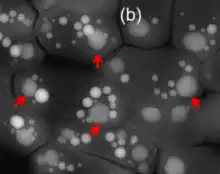Gloeomargarita lithophora
| Gloeomargarita lithophora | |
|---|---|
 | |
| Scientific classification | |
| Domain: | |
| Phylum: | |
| Order: | Gloeomargaritales |
| Family: | Gloeomargaritaceae |
| Genus: | Gloeomargarita |
| Species: | G. lithophora |
| Binomial name | |
| Gloeomargarita lithophora | |
Gloeomargarita lithophora is a cyanobacterium, and is the proposed sister of the endosymbiotic plastids in the Eukaryote Archaeplastida. Gloeomargarita's ancestor would have ended up in an ancestral Archaeplastid through a singular Endosymbiotic event some ~1400 million years ago.[1]
The origin of Plastid endosymbiosis signifies the beginning of photosynthesis in eukaryotes,[2] and as such their evolutionary relationship to Gloeomargarita lithophora, perhaps as a direct divergent,[1] is of high importance to the evolutionary history of photosynthesis. Gloeomargarita appears to be related to a (basal) Synechococcus branch.[3][4][5] A similar endosymbiotic event occurred about 500 million years ago, with another Synechococcus related bacteria appearing in Paulinella chromatophora.[5]
Description
G. lithophora was first isolated in 2007 from microbiolate samples taken from alkaline Lake Alchichica (Mexico). These samples were maintained in a lab aquarium and G. lithophora was isolated from biofilm that occurred within the aquarium. G. lithophora are gram-negative, unicellular rods with oxygenic photoautotrophic metabolism and gliding motility. They contain chlorophyll a and phycocyanin and photosynthetic thylakoids located peripherally. Cells are 1.1 μm wide and 3.9 μm long on average. Growth occurred in both liquid and solid BG-11 growth media, as well as in alkaline water. Optimal growth temperature is 25 °C and optimal growth pH is 8–8.5.[6]
Bioremediation
There is evidence to suggest Gloeomargarita lithophora could serve as a biological buffer to treat water contaminated with Strontium or Barium. This could be a useful application of bioremediation.[7]
References
- 1 2 Betts, Holly C.; Puttick, Mark N.; Clark, James W.; Williams, Tom A.; Donoghue, Philip C. J.; Pisani, Davide (2018-08-20). "Integrated genomic and fossil evidence illuminates life's early evolution and eukaryote origin". Nature Ecology & Evolution. 2 (10): 1556–1562. doi:10.1038/s41559-018-0644-x. ISSN 2397-334X. PMC 6152910. PMID 30127539.
- ↑ Gould, Sven B.; Waller, Ross F.; McFadden, Geoffrey I. (2008). "Plastid Evolution". Annual Review of Plant Biology. 59 (1): 491–517. doi:10.1146/annurev.arplant.59.032607.092915. PMID 18315522.
- ↑ Saw, Jimmy H. W.; Schatz, Michael; Brown, Mark V.; Kunkel, Dennis D.; Foster, Jamie S.; Shick, Harry; Christensen, Stephanie; Hou, Shaobin; Wan, Xuehua (2013-10-23). "Cultivation and Complete Genome Sequencing of Gloeobacter kilaueensis sp. nov., from a Lava Cave in Kīlauea Caldera, Hawai'i". PLOS ONE. 8 (10): e76376. Bibcode:2013PLoSO...876376S. doi:10.1371/journal.pone.0076376. ISSN 1932-6203. PMC 3806779. PMID 24194836.
- ↑ Ponce-Toledo, Rafael I.; Deschamps, Philippe; López-García, Purificación; Zivanovic, Yvan; Benzerara, Karim; Moreira, David (2017). "An Early-Branching Freshwater Cyanobacterium at the Origin of Plastids". Current Biology. 27 (3): 386–391. doi:10.1016/j.cub.2016.11.056. ISSN 0960-9822. PMC 5650054. PMID 28132810.
- 1 2 Sánchez-Baracaldo, Patricia; Raven, John A.; Pisani, Davide; Knoll, Andrew H. (2017-09-12). "Early photosynthetic eukaryotes inhabited low-salinity habitats". Proceedings of the National Academy of Sciences. 114 (37): E7737–E7745. doi:10.1073/pnas.1620089114. ISSN 0027-8424. PMC 5603991. PMID 28808007.
- ↑ Moreira, David; Tavera, Rosaluz; Benzerara, Karim; Skouri-Panet, Fériel; Couradeau, Estelle; Gérard, Emmanuelle; Loussert Fonta, Céline; Novela, Eberto; Zivanovic, Yvan; López-García, Purificación (2017-04-01). "Description of Gloeomargarita lithophora gen. nov., sp. nov., a thylakoid-bearing basal-branching cyanobacterium with intracellular carbonates, and proposal for Gloeomargaritales ord. nov". International Journal of Systematic and Evolutionary Microbiology. 67 (3): 653–658. doi:10.1099/ijsem.0.001679. PMC 5669459. PMID 27902306.
- ↑ Blondeau, Marine; Benzerara, Karim; Ferard, Céline; Guigner, Jean-Michel; Poinsot, Mélanie; Coutaud, Margot; Tharaud, Mickaël; Cordier, Laure; Skouri-Panet, Fériel (20 April 2018). "Impact of the cyanobacterium Gloeomargarita lithophora on the geochemical cycles of Sr and Ba". Chemical Geology. 483: 88–97. Bibcode:2018ChGeo.483...88B. doi:10.1016/j.chemgeo.2018.02.029. ISSN 0009-2541. Retrieved 10 April 2020.